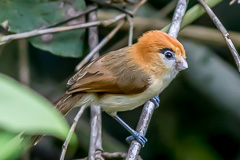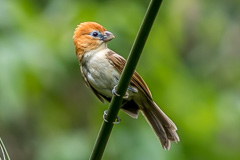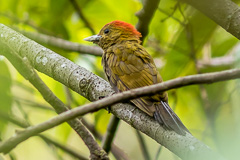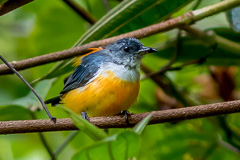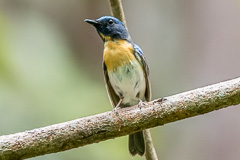Overview
Dates: |
9 - 12 June 2015 |
With Steve Tibbett. The incentive for this trip came from the publication, in Bird Asia 22, of the discovery of a population of Rufous-headed Parrotbill at Mae Moei National Park in western Thailand. Thanks go to Ralph Parks and Nick Upton who had successfully visited Mae Moei in previous months and provided much useful information. In addition to looking for the parrotbill we also aimed to explore forested areas between Hot and Mae Sariang, searching for possible habitat for the long lost Streak-throated Woodpecker - a species not definitely recorded in Thailand for at least 16 years.
9 Jun. We left Chiang Mai early, undertaking a slow drive to the village of Mae Salit, the gateway to Mae Moei National Park. We'd been warned that Highway 105 south from Mae Sariang was in poor condition, but found some extensive repairs were in progress, with now only about 20 kilometres remaining to be worked on. As our secondary aim of the trip was to look for possible habitat for Streak-throated Woodpecker we made several exploratory stops en route. The particular area east of Mae Sariang, from where an old specimen was collected, has now gone and replanted with pines. However, south of Mae Sariang around Mae Ngao National Park, looked somewhat interesting, so we earmarked it for later exploration on the return journey.
We'd had no expectation of finding any accommodation near the park, as the couple of earlier visits had used the basic park accommodation. However, on arrival in Mae Salit, we checked a couple of places in the village and discovered that the New Mae Salit Guesthouse looked fine, as well as having a nearby restaurant - two logistical issues dealt with in one blow. Being western Thailand abutting the Burma mountains, we'd been expecting wet weather, but by mid afternoon it was still hot and dry, so we decided to head straight up the hill into the park and investigate parrotbill areas. The twenty odd kilometre access road into the park is pretty potholed so the journey up took best part of 45 minutes. As the road runs through the park, to several villages, many local people are cutting and collecting throughout the park. Much of the habitat adjacent to the road is further cleared and trashed, and on the face of it does not look that enticing for birding. In typical fashion, just as we arrived the first few spots of rain started falling. However, not to be deterred and armed with umbrellas, we started walking the roadside anyway. Amazingly after only 20 minutes we heard Rufous-headed Parrotbill singing nearby, and were able to get some frustratingly brief glimpses of one bird. A single Pale-billed Parrotbill was far more obliging and perched perfectly in view. These birds disappeared as fast as they had arrived, so we continued to walk farther uphill checking other likely looking bamboo habitat for exploration tomorrow. Collared Babbler and Olive Bulbul were found as well as a very surprising Orange-bellied Flowerpecker, a bird known until recently in Thailand only from the south. On return to the vehicle a further Rufous-headed Parrotbill was calling from the valley bottom but way beyond view, although a pair of Pale-billed Parrotbill were found. With fading light we returned to Mae Salit, just in time for a couple of hours of torrential rain. 10 Jun. Further heavy overnight rain had stopped to reveal a cool and overcast morning. Back up the mountain to arrive, where we'd left off yesterday, by 06.45. We were surprised to encounter a group of bird photographers - mid week in the middle of nowhere; what's the chances of that? No parrotbills seemed present where they had been yesterday, though several White-throated Bulbul were found. We hung around the area for a further hour or so, but as nothing more came along we again continued our exploration up the mountain. Most of the morning till mid afternoon was spent in a series of slow walks birding the forest edge, and we mounted an impressive list, including Violet Cuckoo, Square-tailed Drongo-Cuckoo, Large Hawk-Cuckoo heard, White-browed Piculet, Bamboo Woodpecker, Vernal Hanging Parrot, Silver-breasted Broadbill, Ashy Bulbul, Collared Babbler, Buff-breasted Babbler, Black-throated Laughingthrush, Indian White-eye, Rufous-browed Flycatcher and more Orange-bellied Flowerpecker. |
Before heading down to Mae Salit we again checked the original area and were rewarded with a pair of Rufous-headed Parrotbill feeding quietly at close range.
11 Jun. The drive to Mae Ngao took almost two hours due to the poor road conditions, but it was still dull, overcast and cool when we arrived. The first bird we heard on arrival was Blue-winged Pitta calling from the opposite side of the river. We discovered that the only access to the interior of the park is along the dirt track through the middle. Unfortunately, as with many Thai parks, this track merely connects all the villages inside the park and is cleared for farming along it's entire length. We did persevere with the first few kilometres, that passed though some riverine and dipterocarp forest, but did not look good enough the Streak-throated Woodpecker. It did however produce a nice pair of White-rumped Falcon and a few Common Hill Myna. After 12 kilometres of open fields with barely a bird present, we turned around and headed north again to Mae Sariang.
We next decided to check out Salawin National Park. Here we discovered a 37 kilometre long road passing right through the middle of the park, as far as the Salawin River on the Burma border, and seemingly passing through forest the whole way. This looked extremely productive, and in a few hours we managed to explore the first 16 kilometres of the road. However, the birding proved to be extremely poor with us only recording five species - hard to believe. Returned to Mae Sariang and found some good accommodation along the river.
12 Jun. Not believing the forest of Salawin could be so poor we returned again at dawn, but barely managed ten species in a couple of hours, including Rufous-winged Buzzard and a vocal Blue-winged Pitta. Why is this forest apparently so poor? Time of year? Hunting pressure? Decided to cut our losses and explore further north at Mae Tho National Park, that is located about 50 kilometres east of Mae Sariang. Once near the park, the entrance road would likely deter most casual visitors as a saloon car would not make it.
We have to admit the guys at the barrier were a tad surprised when we drove in - so surprised they simply waved us in and forgot to charge us. This is another park with a local road passing through it, which in addition to clearance and farming is being used as a rubbish tip by passing locals heaving bag loads of rubbish over the side to disappear downslope. Parked the vehicle near the park accommodation and set off downhill, where we found a good, long trail branching off along right and probably originally intended as a firebreak. Habitat was mixed pine and deciduous forest at 1,100 metres and we had a reasonable bird list in a few hours including several Blue-throated Blue Flycatcher. |
Left mid afternoon and headed farther east along Highway 106. Just before Ob Luang National Park, around Huay Bong, our attention was drawn to a wide track heading into Dipterocarp forest that we duly explored. This looked rather promising and the remainder of the afternoon was spent exploring tracks there with some specialists such as Black-headed Woodpecker, Rufous Woodpecker, Red-billed Blue Magpie, Rufous-winged Buzzard and Black Baza. An area worthy of more exploration at a later date. With light running out we returned to Chiang Mai.
Species List
| Mae Moei | Count | Mae Ngao | Count | ||
| Red Junglefowl | 2 | Shikra | 1 | ||
| Common Emerald Dove | 6 | Spotted Dove | 2 | ||
| Greater Coucal | 2 | Greater Coucal | 2 | ||
| Violet Cuckoo | 1 | Large Hawk-Cuckoo | 1 | ||
| Square-tailed Drongo-Cuckoo | 1 | Crested Treeswift | 2 | ||
| Large Hawk-Cuckoo | 1 | Indochinese Roller | 1 | ||
| Asian Barred Owlet | 1 | Coppersmith Barbet | 1 | ||
| Asian Palm Swift | 4 | Bay Woodpecker | 1 | ||
| Lineated Barbet | 1 | White-rumped Falcon | 2 | ||
| Blue-throated Barbet | 3 | Blue-winged Pitta | 1 | ||
| White-browed Piculet | 2 | Hair-crested Drongo | 4 | ||
| Greater Yellownape | 1 | Greater Racket-tailed Drongo | 2 | ||
| Bamboo Woodpecker | 2 | Common Hill Myna | 3 | ||
| Bay Woodpecker | 1 | ||||
| Vernal Hanging Parrot | 4 | Huay Bong | Count | ||
| Silver-breasted Broadbill | 2 | Eastern Cattle Egret | 1 | ||
| Scarlet Minivet | 4 | Black Baza | 2 | ||
| White-bellied Erpornis | 2 | Rufous-winged Buzzard | 1 | ||
| Bronzed Drongo | 8 | Red-wattled Lapwing | 2 | ||
| Lesser Racket-tailed Drongo | 2 | Indochinese Roller | 1 | ||
| White-throated Fantail | 2 | Lineated Barbet | 2 | ||
| Common Green Magpie | 2 | Black-headed Woodpecker | 5 | ||
| Grey Treepie | 4 | Rufous Woodpecker | 3 | ||
| Eastern Jungle Crow | 2 | Hair-crested Drongo | 4 | ||
| Grey-headed Canary-flycatcher | 2 | Red-billed Blue Magpie | 5 | ||
| Black-headed Bulbul | 8 | Eastern Jungle Crow | 1 | ||
| Black-crested Bulbul | 10 | Black-collared Starling | 4 | ||
| Stripe-throated Bulbul | 2 | Scaly-breasted Munia | 2 | ||
| Flavescent Bulbul | 6 | ||||
| White-throated Bulbul | 12 | Mae Tho | Count | ||
| Olive Bulbul | 30 | Greater Coucal | 2 | ||
| Ashy Bulbul | 4 | Blue-bearded Bee-eater | 3 | ||
| Yellow-bellied Warbler | 6 | Blue-throated Barbet | 4 | ||
| Hill Prinia | 2 | Grey-capped Pygmy Woodpecker | 3 | ||
| Common Tailorbird | 2 | White-bellied Erpornis | 2 | ||
| White-browed Scimitar Babbler | 2 | Lesser Racket-tailed Drongo | 2 | ||
| Grey-throated Babbler | 6 | Black-naped Monarch | 4 | ||
| Rufous-fronted Babbler | 10 | Black-headed Bulbul | 6 | ||
| Pin-striped Tit-Babbler | 25 | Black-crested Bulbul | 5 | ||
| Brown-cheeked Fulvetta | 12 | Sooty-headed Bulbul | 4 | ||
| Collared Babbler | 3 | Grey-eyed Bulbul | 10 | ||
| Puff-throated Babbler | 8 | Ashy Bulbul | 4 | ||
| Buff-breasted Babbler | 4 | Common Tailorbird | 2 | ||
| Black-throated Laughingthrush | 1 | Brown-cheeked Fulvetta | 2 | ||
| Pale-billed Parrotbill | 2 | Velvet-fronted Nuthatch | 3 | ||
| Rufous-headed Parrotbill | 4 | Oriental Magpie-Robin | 2 | ||
| Indian White-eye | 10 | White-rumped Shama | 10 | ||
| White-rumped Shama | 15 | Blue-throated Blue Flycatcher | 4 | ||
| Rufous-browed Flycatcher | 3 | Ruby-cheeked Sunbird | 2 | ||
| Hill Blue Flycatcher | 2 | ||||
| Northern White-crowned Forktail | 1 | Salawin | Count | ||
| Orange-bellied Flowerpecker | 4 | Black Baza | 5 | ||
| Ruby-cheeked Sunbird | 2 | Shikra | 1 | ||
| Little Spiderhunter | 2 | Greater Coucal | 3 | ||
| Streaked Spiderhunter | 6 | Large Hawk-Cuckoo | 2 | ||
| Asian Barred Owlet | 1 | ||||
| White-throated Kingfisher | 4 | ||||
| Lineated Barbet | 2 | ||||
| Grey-capped Pygmy Woodpecker | 1 | ||||
| Blue-winged Pitta | 1 | ||||
| Black-hooded Oriole | 2 | ||||
| Bronzed Drongo | 2 | ||||
| Greater Racket-tailed Drongo | 6 | ||||
| Black-naped Monarch | 4 | ||||
| Eurasian Jay | 2 | ||||
| Black-crested Bulbul | 2 | ||||
| Sooty-headed Bulbul | 4 | ||||
| Rufescent Prinia | 2 | ||||
| Common Tailorbird | 2 | ||||
| Rufous-fronted Babbler | 2 | ||||
| Puff-throated Babbler | 2 |

